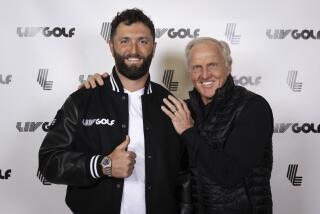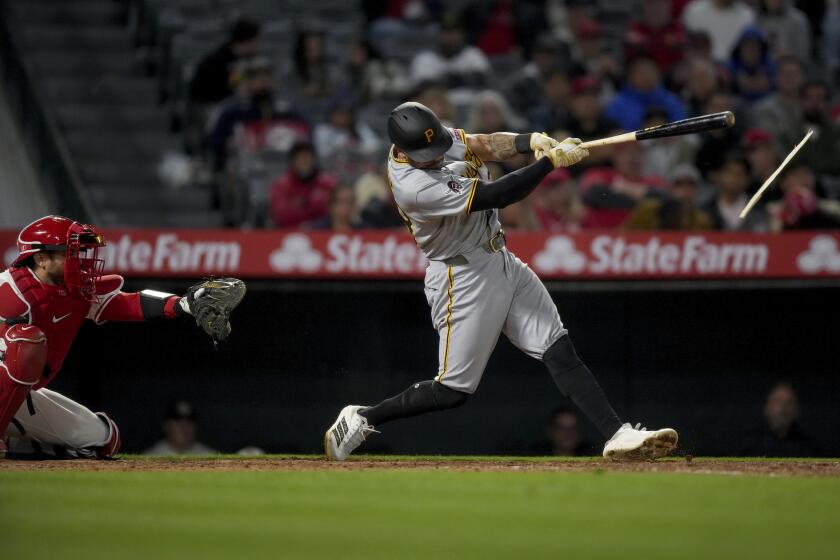Pro Bowlers Operate on the Pay to Play Plan
- Share via
When you are a star football or basketball player ready to graduate to the professional ranks, life is sweet. Your team gives you a good salary, pays for your travel and living expenses and provides trainers and a host of other benefits.
If you are an aspiring bowling professional, however, it’s a little more complicated. You pay the Professional Bowlers Assn. to become a pro, you pay your way into events, and you pay your own expenses. All to compete for a total prize fund that is equal to fifth-place money in a PGA tournament.
Why do rookies try it?
“It’s very simple,” says Brad Angelo, the leading candidate for rookie of the year in the PBA. “I fell in love with bowling at an early age, and it was never about the money. I just love to bowl.”
Adds Brett Wolfe, another rookie, “If you go on the pro tour to win money, you’re probably in the wrong sport. If you are really good, you want to find out how good you are against the best. You want to find out if you can really hang with the pros.”
There is money to be made, of course. Walter Ray Williams Jr., considered by some to be the best bowler of all time, has won $192,500 so far this season and is nearing $3 million in career earnings. Williams and other good bowlers also are on the staffs of ball manufacturers and receive endorsements that often pay more than they win bowling.
But the money drops off rather quickly. By the time you get to No. 7 on this season’s money list, Robert Smith of Simi Valley has earned only $85,000.
Angelo is No. 29 and has gotten a paycheck in 12 of the 13 tournaments he has entered, but they have totaled only $36,080. Wolfe has cashed only twice in 12 events for a total of $2,200.
Wolfe’s story is enlightening because it shows how humbling the PBA experience can be. As an amateur, the 25-year-old Tempe, Ariz., resident entered the prestigious ABC Masters tournament in Reno last January and simply dominated. He was the first amateur to lead all bowlers in qualifying for the tournament, and only the sixth to win it -- taking home $100,000.
He became a pro this season but has struggled, averaging only 201.
“There is a real transition in the caliber of players you are up against,” he said. “You might have been the best bowler in your league at home, or even the best bowler in town -- but so was everybody else. Nobody is in awe of you.”
At the other extreme is Angelo, 33, from Lockport, N.Y. Before joining the tour this year, Angelo supported himself for 13 years by bowling in big-money amateur tournaments and on Team USA. His father, Anthony “Nin” Angelo, was a touring pro many years ago, “back in the days with Carmen Salvino, Dick Weber and Don Carter,” so Brad learned young and got excellent instruction.
“In high school, I was a pitcher and a quarterback and a point guard, but I loved bowling more than anything,” he said.
Even so, the tour can be intimidating.
“My biggest challenge this year is looking to my right and seeing Pete Weber, looking two lanes to the left and seeing Walter Ray Williams -- guys that I watched as I was coming up through the ranks and admired for their abilities. Now I can rub shoulders with them. That’s the biggest excitement about being on tour finally.”
But there is a ton of stress along with it, he added.
“Our income is based on performance. Tell a linebacker in the NFL that he is going to get $1,500 every time he makes a tackle, but lose money every time he gets a penalty. Watch how different things would be. They get paid whether they perform or not,” at least until their contracts expire. “We don’t.”
Added Billy Myers Jr., who was on the tour for four years but now operates three pro shops in the Los Angeles area, “It’s like going to school, but if you don’t get good grades, they send you home.”
Myers, 29, made the televised finals four times, with a best finish of third at the Johnny Petraglia Open on March 11, 1995.
He made money but was discouraged by the low prize pool.
With the increase in prize money now, he is planning to go back out on tour at least part-time.
“I really miss the competition,” he said. “I don’t mean to be cocky, but I’m talented and I know I can compete. But the question I have to ask is, ‘Can I take care of myself?’ If I go back out, where will I be when I am 50?”
But, he added, “It’s a blessing to be able to do something you love.”
And new guys keep lining up.
Edmund Rede, 26, is a mechanical engineer who came to Los Angeles to work for Northrop Grumman Corporation and has been dominating the local leagues he bowls in. Both he and his twin brother Edward are itching to get on the tour, but neither has found a sponsor willing to put up the $30,000 or so necessary to make a real effort.
“You have to figure on $1,100 to $1,500 a week for entry fees, travel, lodging, meals and other expenses,” Rede said. “That’s a lot of money.”
After two days of qualifying (12 games) for the U.S. Open, a PBA tour event this week at Fountain Bowl in Fountain Valley, Angelo was tied for 19th with 2,499 pins, Wolfe was in 155th place with 2,276, Myers was tied for 160th with 2,269, and Rede was tied for 220th with 2,157 pins.
More to Read
Go beyond the scoreboard
Get the latest on L.A.'s teams in the daily Sports Report newsletter.
You may occasionally receive promotional content from the Los Angeles Times.










